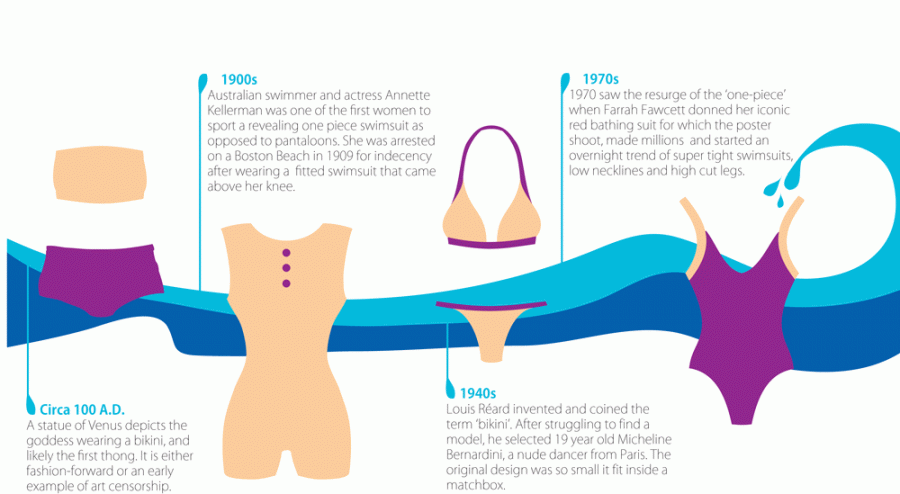
I was absolutely shocked and embarrassed for her; I didn’t think a woman would dare expose so much skin.
It really upsets me because swimsuits that are this revealing are becoming more and more common. The definition of modesty is ever-changing, and unfortunately not in a good way.
As our generation redefines modesty, it is also affecting the lack of respect men display towards women. The more revealing a swimsuit is, the less likely it is that a guy will want to talk to a girl based on her personality. With swimwear especially, there needs to be a stopping point with how revealing they are; otherwise, the lack of modesty in swimsuits will continue to worsen, causing the lack of respect women receive from men to decline.
Just 60 years ago, it was completely unacceptable for women to even wear bikinis. In fact, beauty pageants banned bikinis in 1951 after the Miss World Contest. As late as 1959, women could be fined $5 for wearing a bikini on New York’s Rockaway Beach. Previously, in 1931, a law was placed: The Local Government Act, Ordinance No. 52, that set exact dimensions for swimsuits.
For example, men’s and women’s swimwear had to have legs at least three inches long, had to completely cover the front body from the armpits to the waist and had to have shoulder straps or other means of keeping the swimsuit in position. The law lasted until 1961, but should have lasted longer, in my opinion.
Obviously, that’s not even close to where the standards for swimwear stand today. So what happened?
In the 1960s, a series of cultural reforms changed the United States, including the modesty of swimwear. After Brian Hyland came out with his classic song, “Itsy Bitsy Teeny Weeny Yellow Polka Dot Bikini” in 1961, the song triggered a bikini-buying spree among American teens, thus revising the definition of swimsuit modesty forever more.
After the United States accepted the bikini, the modesty of swimsuits rapidly decreased. Fashion designers introduced the monokini, the thong bikini and increasingly immodest bikinis that are still being produced today.
I think the United States should have definitely stopped with the bikinis worn in the 1960s. They were fashionable, still fairly modest and flattering on almost everyone. Bikinis now are immodest and not necessarily flattering. The most unflattering bikinis I have seen, no matter how fit and skinny you are, are definitely thong bikinis.
The fact that thong bikinis exist truly disgusts me. Would you wear an actual thong in public? Probably not, since according to Women’s Health Magazine, only two percent of women in the United States do.
Bikinis reveal way more than most peoples’ underwear shows, which should be a hint to most people that it’s time to rethink what they are wearing in public.
If this bikini fabric decline continues any further, we will soon be living in a world where nude beaches are a daily occurrence and where women don’t have any respect for themselves.
Women need to show appreciation for themselves by taking a stand against this bikini evolution by dressing in more modest swimwear styles.Women complain about the lack of chivalry, but how can men demonstrate chivalry toward us when we aren’t dressing in a way that shows that we have respect for ourselves?
Dressing in a less revealing swimsuit can cause men to have more respect for us because they won’t just be admiring us for our bodies, but for our personalities. Therefore, this will help to prevent the decrease of chivalry we see in men today, thus allowing for chivalry to make its way back into the world.
So women, out of respect for yourself and your future family, stand up against the decay of chivalry and respect. You can do this simply by changing your swimsuit.

















































































Anna • May 22, 2019 at 1:42 pm
You Americans are so weird, in East Germany where I live, many people went swimming in the nude for decades, children and adults alike, it was part of the culture (and still is for many people who grew up in those times) and nobody batted an eye. Self-respect and revealing clothing are not mutually exclusive. I’m saying that as an evangelical Christian myself.